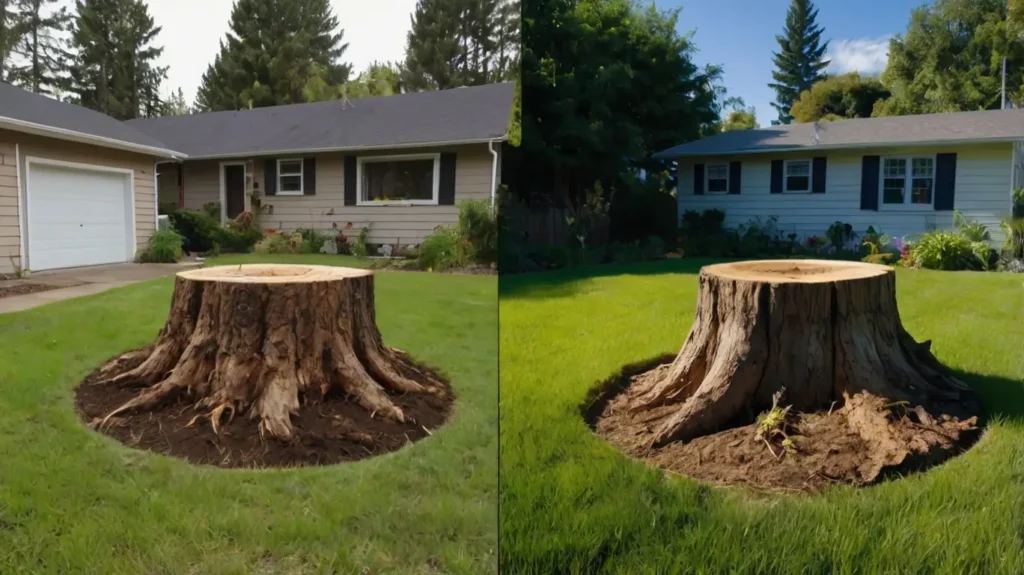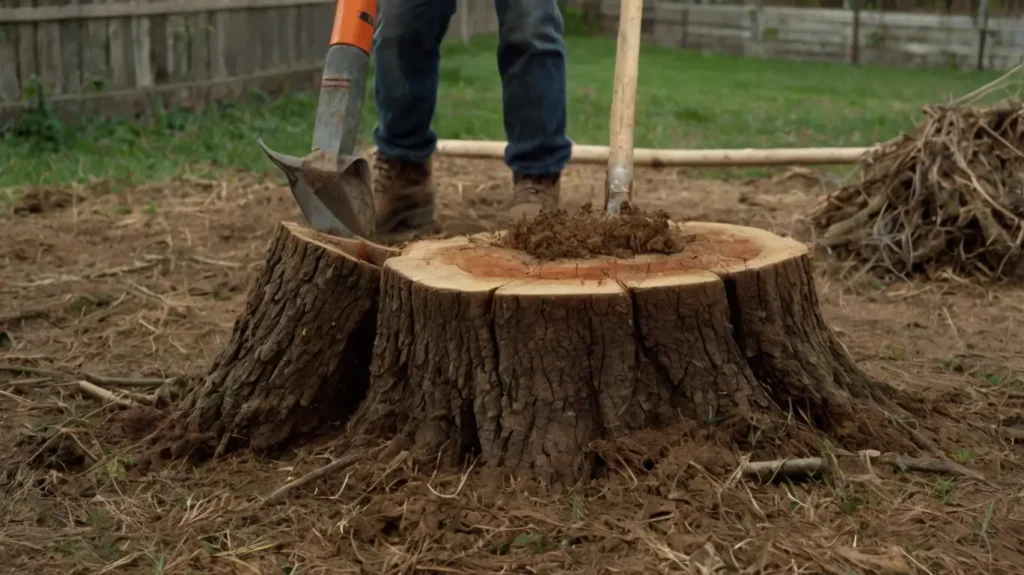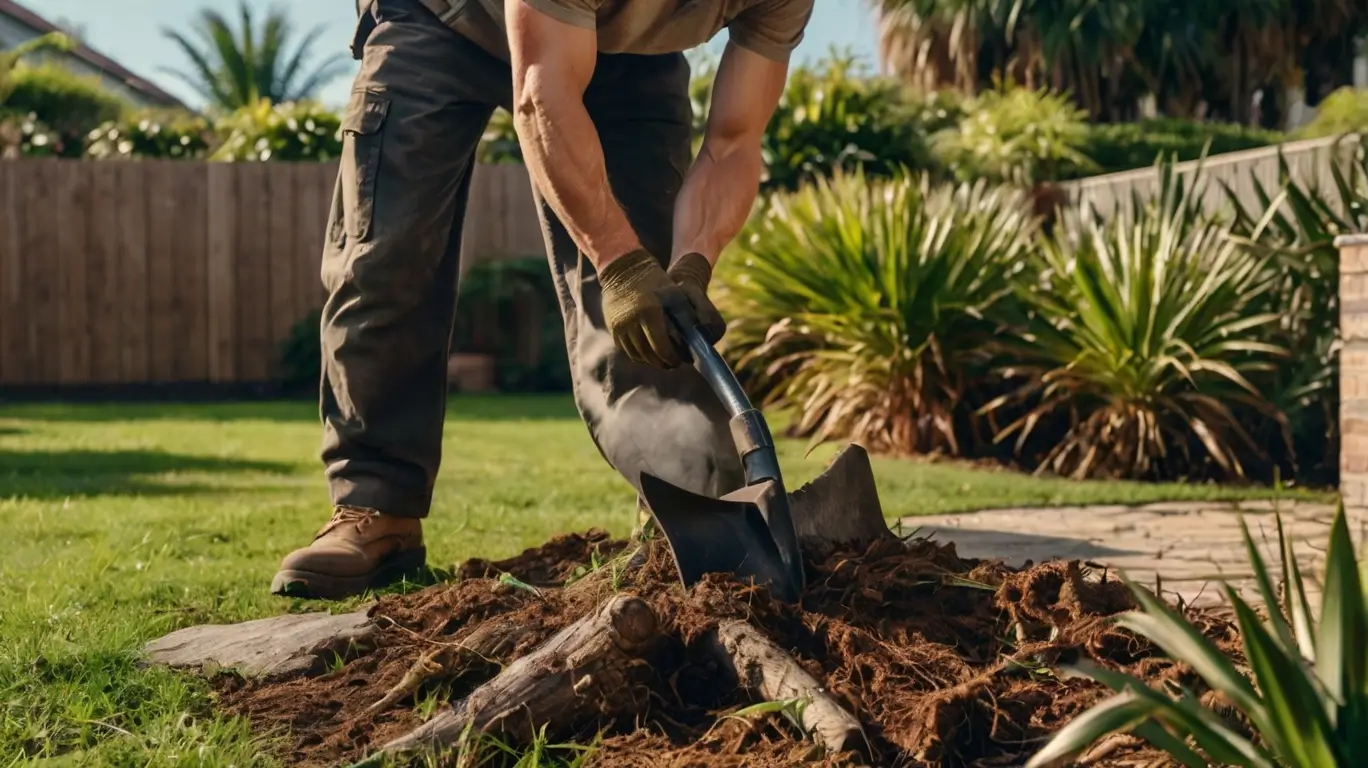How to Remove a Small Palm Tree Stump the Right Way
Introduction: A Personal Touch to Stump Removal
If you’ve ever had a small palm tree in your garden, you know how easily it becomes more than just a plant—it turns into a part of your outdoor sanctuary. The sight of its feathery fronds swaying in the breeze can evoke a sense of calm, and letting go of that can be difficult.
But what happens when your palm tree becomes too large, unhealthy, or in the way of a new project? You’re left with the task of removing it, and specifically, learning how to remove a small palm tree stump.
Having dealt with the process myself, I understand how overwhelming it might feel. You’ve nurtured that palm tree, and removing its stump might seem like a daunting task.
However, the good news is that with the right approach, removing a small palm tree stump can be both manageable and even satisfying. Plus, once it’s gone, you’ll have the freedom to design the area however you like.
This guide will walk you through a simple, stress-free method for removing a palm tree stump. Whether you’re making space for a new plant or just clearing the garden, by following these steps, you’ll get the job done efficiently and with minimal hassle.
Why You Need to Remove a Small Palm Tree Stump

When it comes to how to remove a small palm tree stump, it’s not just about clearing space—it’s about improving your garden’s health and aesthetics.
While you might feel sentimental about the palm tree you once nurtured, leaving the stump behind can lead to a number of practical issues. Here’s why removing the stump is an essential step in your garden care routine.
Aesthetic Improvement
The most obvious reason to remove a small palm tree stump is to improve the appearance of your garden. A leftover stump can be an eyesore, disrupting the flow and beauty of your landscape.
Whether you’re looking to plant something new or just want a cleaner look, removing the stump can open up fresh possibilities for aesthetic enhancement.
Preventing Regrowth
Another key reason to tackle stump removal is to avoid unwanted regrowth. Palm trees, even when cut down, can often produce new shoots from their stumps.
By learning how to remove a small palm tree stump, you prevent these shoots from sprouting, ensuring that your garden doesn’t become overrun with the same plant you were trying to remove in the first place.
Space for New Plants
When you remove a stump, you open up space for other plants to thrive. This is especially important if you’re redesigning your garden or trying to introduce new species.
Removing a stump gives you a fresh canvas for more vibrant or diverse plantings. Plus, it eliminates any competition for nutrients and space, giving your new plants a better chance of growing strong and healthy.
Safety Concerns
Stumps can also pose a safety risk. They can become tripping hazards or get in the way of your daily garden activities. Moreover, stumps may start to rot over time, which can attract insects like termites or carpenter ants.
If left untreated, these pests can spread to nearby plants or even your home. Knowing how to remove a small palm tree stump properly eliminates the possibility of such issues, keeping your garden and home safe.
Pests, Fungi, and Diseases
One of the more concerning consequences of leaving a stump unattended is that it can become a breeding ground for pests, fungi, and diseases. As the stump decomposes, it can attract termites, ants, and other wood-boring insects. These pests can cause damage not only to the stump but to nearby plants and structures as well.
Additionally, fungi can thrive in a damp stump, leading to diseases that may spread to your garden. By learning how to remove a small palm tree stump, you take control of these risks and ensure that your garden remains healthy and pest-free.
In summary, removing a small palm tree stump serves several practical purposes, from beautifying your space to preventing regrowth and eliminating health risks. Taking the time to properly remove a stump might seem like a daunting task, but the benefits far outweigh the effort.
Whether you’re improving the look of your garden, creating room for new plants, or keeping pests at bay, stump removal is an important step in maintaining a thriving outdoor space.
Tools You’ll Need to Remove a Small Palm Tree Stump
When you’re figuring out how to remove a small palm tree stump, having the right tools can make the entire process much easier and more efficient.
The tools you use will depend on the size of the stump, the method you choose, and your available resources. Here’s a breakdown of the essential tools you’ll need for successful stump removal:
Axe, Saw, or Hand Saw
To start with, cutting through the stump and roots requires a sharp, sturdy tool. An axe or hand saw is ideal for this. These tools are perfect for cutting through smaller roots and getting a clear cut on the stump.
If the roots are thick and stubborn, a saw may provide more precision and power, allowing you to tackle the stump effectively. If you’re asking yourself how to remove a small palm tree stump using hand tools, these will be your go-to equipment.
Stump Grinder (Optional)
If you have access to a stump grinder, this can make the job faster and less physically demanding. A stump grinder is a powerful machine that grinds the stump down into mulch, making it easier to clear the area afterward.
If you have a larger stump or want to speed up the process, renting a stump grinder might be worth the investment. If you’re wondering how to remove a small palm tree stump efficiently, a stump grinder is a game-changer.
Shovel, Trowel, or Spade
For removing soil around the stump, a shovel, trowel, or spade will be necessary. These tools are crucial for loosening the soil and uncovering the roots. Digging around the stump makes it easier to access the roots, which need to be severed before the stump can be fully removed.
Depending on the size of your stump, you may want to choose a tool that gives you more leverage, such as a spade for deeper digging or a trowel for smaller, more precise work.
Pruning Shears
If the roots are relatively small, pruning shears can help trim them back. These compact tools are great for cutting through thinner roots and foliage that might be tangled around the stump.
They offer a more delicate approach compared to an axe or saw, so you can target the smaller roots without damaging the rest of your garden. For those wondering how to remove a small palm tree stump in a controlled manner, pruning shears can help make the process easier and more precise.
Gloves
Stump removal can be a rough job, and you’ll want to protect your hands from splinters, rough edges, and dirt. Wearing gloves will help keep your hands safe while you work.
Since palms can have sharp, prickly edges, gloves are essential for providing a layer of protection throughout the process. You’ll thank yourself later when you’re not dealing with blisters or cuts. So, when learning how to remove a small palm tree stump, don’t forget to equip yourself with a solid pair of gardening gloves!
Watering Can or Hose
Moistening the stump and the surrounding soil makes the process easier. Using a watering can or hose to moisten the area can soften the soil, making it less compact and easier to dig. Moist soil also helps loosen stubborn roots, making the stump removal much smoother.
This is particularly helpful when you need to dig deeper around the roots. If you’re wondering how to remove a small palm tree stump without excessive effort, this simple trick will reduce strain and allow you to work more efficiently.
Essential Tools Checklist:
- Axe, saw, or hand saw (for cutting through roots and stump)
- Stump grinder (optional for faster grinding)
- Shovel, trowel, or spade (for loosening soil and digging around roots)
- Pruning shears (for cutting smaller roots)
- Gardening gloves (to protect hands)
- Watering can or hose (to moisten the stump and soil)
In summary, knowing how to remove a small palm tree stump efficiently requires having the right tools for the job.
Each tool has its own role in the process, from cutting and digging to protecting your hands. If some of these tools aren’t available, there are always substitutions that can work, but having them will certainly make your stump removal journey much smoother.
Step-by-Step Guide on How to Remove a Small Palm Tree Stump the Right Way

Removing a small palm tree stump is a task that requires careful planning and the right approach to ensure success.
By following a clear, step-by-step process, you can tackle this job like a pro. In this section, we’ll walk you through the essential steps for how to remove a small palm tree stump efficiently and safely.
Step 1: Assess the Stump’s Size and Location
Before you get started on how to remove a small palm tree stump, it’s important to take a moment to assess the situation. Evaluating the size of the stump and its location will help determine the best method for removal, whether you’re using manual labor or a stump grinder.
1. Measure the Size of the Stump
The size of the stump plays a significant role in the type of removal technique you should use. For smaller stumps, manual digging and cutting may suffice, while larger stumps may require a stump grinder for faster and more effective removal.
Understanding the how to remove a small palm tree stump in relation to its size will help you decide whether to use hand tools like an axe or saw or go for more advanced machinery.
- Small stump: If the stump is relatively small (under 12 inches in diameter), you can likely handle the job with manual tools like a shovel, hand saw, and pruning shears. How to remove a small palm tree stump manually is usually doable with patience.
- Medium or larger stump: If the stump is bigger or deeply rooted, a stump grinder can speed up the process. However, for those still asking how to remove a small palm tree stump without heavy machinery, a deeper effort with tools might still do the trick.
2. Examine the Proximity to Other Objects
Next, assess the stump’s location in relation to other plants, structures, or objects. If the stump is located near buildings, fences, or other plants, you’ll need to be extra cautious. Understanding the layout of the space will guide you in taking the safest and most effective steps.
- Nearby plants: Ensure that you avoid damaging any nearby plants or landscaping when digging around the stump. If you’re unsure of how to remove a small palm tree stump in a crowded garden space, consider trimming or protecting surrounding foliage first.
- Structures and obstacles: If the stump is near a building or fence, use caution when cutting or grinding it down. You may want to consider using a hand saw to control the cutting process more precisely.
Key Points to Consider:
- Take measurements of the stump to gauge the best removal method.
- Be aware of surrounding obstacles, which might require extra steps for protection.
- If the stump is small and isolated, manual removal might be the best option.
- If the stump is larger or close to structures, using a stump grinder or digging deeper might be necessary.
By thoroughly evaluating the stump and its environment, you’ll be ready to decide how to remove a small palm tree stump safely and effectively. Once you know the size and location, you’ll be able to choose the most suitable tools and techniques for the job.
Step 2: Cut Away the Palm Tree Trunk (If Necessary)
If the palm tree trunk is still protruding above ground, it’s essential to cut it down to ground level before proceeding with the stump removal process. By removing the excess trunk, you’ll have easier access to the stump itself, making it more manageable for removal. Here’s how to do it:
- Use a Saw or Axe: For small stumps, a hand saw or axe should suffice. If the trunk is thicker, consider using a chainsaw to cut it down to ground level. Ensure the saw or axe is sharp to avoid unnecessary effort and frustration.
- Safety First: When using sharp tools like saws or axes, always wear protective gloves to prevent injury. Eye protection is also crucial to protect from flying debris. Make sure the area around you is clear of obstacles or people before starting.
Key Points:
- Cutting the trunk will expose the stump more effectively, making it easier to remove.
- Wearing gloves, eye protection, and appropriate clothing is vital for safety.
- Properly secure the area to ensure no one is in harm’s way during the cutting process.
Step 3: Loosen the Soil Around the Stump
Once the trunk is removed, it’s time to focus on the stump itself. Loosening the soil around the stump will make it easier to remove. Follow these steps to prepare the soil for stump extraction:
- Watering the Soil: Moisten the soil around the stump by using a watering can or hose. Softening the soil with water allows the roots to loosen more easily, reducing the effort needed to pull the stump out. Water the area thoroughly a few hours before you start.
- Loosening the Soil: Use a shovel, spade, or trowel to dig around the stump. Work your way in a circle, gradually loosening the soil. This process helps free the roots from the earth and makes the stump removal much easier.
Key Points:
- Watering the soil around the stump softens it, making it more pliable.
- Digging around the stump helps break up compacted soil and exposes roots for easier removal.
- Taking time to loosen the soil reduces strain when pulling out the stump.
Step 4: Remove the Stump from the Ground
Now comes the critical step of removing the stump from the ground. There are two main methods to achieve this, depending on the tools at your disposal.
- Manual Removal: If you’re manually removing the stump, use a shovel to pry the stump out. Leverage can be a game-changer here; use a long bar or sturdy tool to lift the stump. Once it’s loosened, pull the stump out, taking care not to damage surrounding plants.
- Stump Grinder: If you’re using a stump grinder, carefully guide the machine over the stump, grinding it down bit by bit until the stump is removed below ground level. This method is much faster but requires specialized equipment.
- Roots: Don’t forget the roots! You may encounter stubborn roots that need to be cut or pried loose using a saw or axe. For larger roots, using a stump grinder or digging them out with a pickaxe is recommended.
Key Points:
- Use leverage to pry the stump out manually if you’re not using a stump grinder.
- Stubborn roots may need additional cutting or grinding to fully remove the stump.
- A stump grinder is more efficient for larger or more entrenched stumps.
Step 5: Dispose of the Stump Properly
Properly disposing of the stump is as important as the removal itself. Leaving the stump to rot on your property can lead to pest infestations or disease spread, so it’s crucial to handle disposal appropriately.
- Chipping or Mulching: If you have the necessary equipment, you can chip the stump into mulch, which can then be used around your garden. This is an eco-friendly option that can also enrich your garden soil.
- Composting: Alternatively, you can compost smaller palm tree stumps, as they’ll break down naturally over time. However, this method requires a large compost bin and time to break down the material.
- Remove the Stump from the Yard: If you don’t want to keep the stump, consider hauling it away to a proper disposal site. Many local waste management services offer stump disposal.
Key Points:
- Dispose of the stump by chipping it into mulch or composting it.
- Avoid leaving the stump to rot, as it can attract pests and fungi.
- Check local disposal services for stump removal options.
After Stump Removal: How to Restore Your Yard

Now that the stump is removed, you’re left with a hole that needs attention. Here’s how to restore your yard:
- Fill the Hole: Use fresh soil to fill in the hole where the stump once stood. This helps level the ground and prevents water from pooling in the hole.
- Replant: If you plan on planting a new palm tree or another plant in the same spot, ensure that the soil is properly prepared and aerated. You might also consider seeding the area with grass to blend it with the surrounding lawn.
- Alternative Uses: If you don’t want to replant, you can use the cleared space for another landscaping project, such as creating a flower bed, laying down a path, or adding a decorative feature like a fountain or birdbath.
Key Points:
- Fill the hole with fresh soil to restore your yard’s appearance.
- Replant or use the area for a different landscaping project.
- Consider using grass seed for a quick recovery of the area.
Common Mistakes to Avoid When Removing a Palm Tree Stump
When removing a small palm tree stump, there are a few common mistakes to avoid. Here’s a quick guide to keep you on track:
- Not Assessing the Size and Location of the Stump: Before starting, evaluate the stump’s size and location. Failing to do this may result in using the wrong tools or damaging nearby plants.
- Forgetting to Properly Dispose of the Stump: Leaving the stump behind can cause problems like pest infestations, fungi, and an unsightly yard. Always dispose of the stump properly.
- Overworking the Soil: While it’s tempting to dig up as much of the stump’s root system as possible, overworking the soil can damage your yard. Focus on removing the roots that are in the way without digging too aggressively.
Key Points:
- Take time to assess the stump before starting removal.
- Always dispose of the stump properly to avoid long-term issues.
- Be mindful of not overworking the soil or damaging the surrounding area.
Conclusion: Enjoy Your Stump-Free Yard
In conclusion, how to remove a small palm tree stump doesn’t need to be an overwhelming task. By following the steps outlined above and using the proper tools, you can remove your stump effectively and restore your yard to its original beauty.
Remember, a successful stump removal process comes down to preparation, the right tools, and attention to detail.
By taking the time to assess, cut, loosen, and properly dispose of the stump, you’ll be left with a clean, stump-free space ready for new projects. So, gather your tools, follow the steps, and enjoy the satisfaction of a job well done. Your yard will thank you for it!
FAQs About How to Remove a Small Palm Tree Stump the Right Way
When tackling a small palm tree stump, questions are bound to arise. Here are some common inquiries along with helpful answers that should guide you through the process of removing a small palm tree stump effectively.
Q1: Can I remove a palm tree stump myself?
Answer: Yes, you can absolutely remove a small palm tree stump yourself! With the right tools and approach, it’s a manageable task.
Manual methods require some physical effort, but for smaller stumps, you’ll only need a shovel, saw, and some patience. If you have access to a stump grinder, that will speed up the process, but it’s not always necessary for smaller stumps.
Q2: Do I need special equipment to remove a small palm tree stump?
Answer: For small palm tree stumps, special equipment isn’t always necessary. Basic tools like a saw, shovel, and pruning shears should suffice for manual removal.
However, if you want to get rid of the stump more quickly or if the stump is larger or more stubborn, a stump grinder can make the job easier and faster. Consider using a grinder if you’re removing multiple stumps or one that’s deeply rooted.
Q3: How do I know when it’s the right time to remove the stump?
Answer: The best time to remove a small palm tree stump is after you’ve completely cut down the tree and cleared away any remaining debris. You’ll want to ensure that you’re not removing a stump prematurely.
Once the palm tree is fully removed, that’s the ideal moment to reclaim the space, whether it’s for new plantings or other landscaping projects.
Q4: What should I do with the stump after removing it?
Answer: After you’ve removed the stump, there are several disposal options available. You can chip it into mulch, compost it, or dispose of it through your local waste management service.
Chipping is particularly useful because it provides nutrient-rich material for your garden. If you don’t want to deal with disposal yourself, some tree removal services offer stump removal and disposal as part of their package.
Table: Comparison of Palm Tree Removal Methods
| Method | Tools Needed | Time Required | Difficulty | Best For |
|---|---|---|---|---|
| Manual Removal | Shovel, Axe, Pruning Shears | 1-3 hours | Medium | Small, accessible stumps |
| Stump Grinding | Stump Grinder | 30 mins – 1 hr | Easy | Larger, more stubborn stumps |
| Chemical Removal | Epsom Salt, Drill | 1 week+ | Low | Slow, chemical process |
This comparison helps you determine the method that best suits your specific needs when considering how to remove a small palm tree stump.

